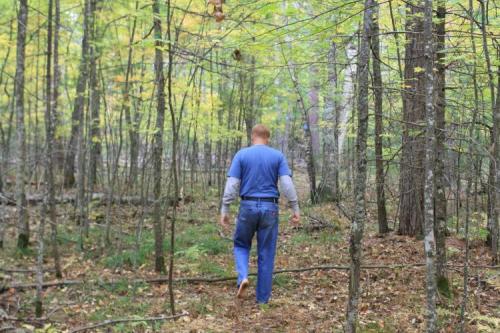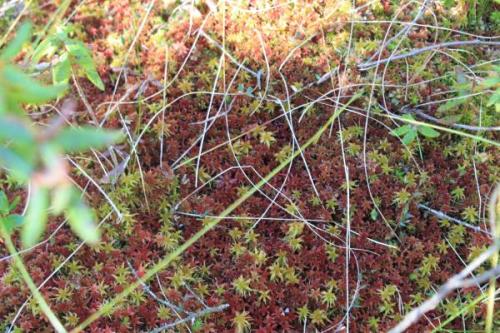I had a chance to do a bit of a bushwhack, make that a bogwhack, the other day.
Of course, if you are sloggin’ through a bog, bare feet are best.
I’ve hiked a bit up here in northern Wisconsin. The trails (also the off-trails) are pretty stimulating for the soles. Here’s a shot from last year as I was hiking along.
This year, I started along the same track, and came across this little guy right in the middle of the trail.
He must have died pretty recently, since I didn’t see any signs of maggots or anything.
I had decided to try to hike a bit farther afield. Two years ago I’d skirted the edge of a small bog, but I wanted to do more. Here’s a map of the boggy area.
The spot I’d been to before was to the south there, along the red line. This time I aimed for what looked like a lake surrounded by bog.
On that map, the purple line shows what looks like an old road. The blue line marks where I walked. It’s a little trickier hiking through a bog—there is no topography once you are in it (though aiming for higher ground can help get you out). Other than that, I was thankful for a sunny day; I used the sun for my navigation.
These bogs are left over from the times of the glaciers. The glaciers scraped out low spots that have slowly filled in.
The really cool thing about hiking through this bog is that the flora was so different from what I am used to. Much of the walking surface was sphagnum.
I’m pretty sure this is Sphagnum warnstorfii.
Going through the bog, at least along the edge, was actually fairly difficult. It was much thicker that a normal forest floor. Here’s what one of the “paths” looked like.
The ground there is more sphagnum, and there were stunted spruce trees all around.
Here’s another shot of the sphagnum.
While the main surface was all sphagnum, there seemed to be some sorts of paths carved into it. At first I thought they might have been drainage paths, but they kept criss-crossing each other. So I imagine some animal of some sort had made them. Beavers? Otters?
The trails often cut quite deep into the sphagnum.
As I got closer to the lake, things opened up a little bit, and the mix of plants changed, too. Here I was starting to see a bit of cotton grass.
Eventually, it got too wet for the spruces to be able to do much of anything. Here we are right on the edge of the trees, and I managed to see the lake in the middle of things.
By the way, I just cannot imagine having explored along here in anything but bare feet. They were perfect, and the textures and sensations walking along were a wonderful new experience.
I also wasn’t the least bit concerned about “stepping on something”. I could handle rough woods—I didn’t foresee there was anything here my feet couldn’t handle. (And yes, they did just fine.) The only thing I worried about (just a little bit) was stepping into a deep hole. Fortunately, I didn’t come across one.
As I got closer to the lake, the amount of water under the sphagnum increased. Within about 10 feet, I was slogging along.
(Can you just imagine trying to wear boots? Seems impossible, or at least horribly uncomfortable.)
Here’s a picture from the edge of the open water.
You can see cotton grass puffballs all over the place.
On the edge of the lake here, the water was even deeper.
You can also see different varieties of sphagnum. (I think that’s Sphagnum fuscum on the left.)
From there, I was able to look back at where I’d come from.
You can see the succession from the highlands in the distance, to the lower spruce fields, to the pure bog area.
Finally, I left one picture for last, because it was the best. Near the lake, mixed in among the sphagnum, was this plant.
That is a Purple Pitcher Plant, Sarracenia purpurea purpurea. Purple Pitcher Plant: say that three time fast.
[A special thanks to Professor Emmet Judziewicz of the University of Wisconsin at steven’s Point for helping me identify the plant.]
Those are the leaves of the plant—the flower is long gone. What’s interesting about this plant is that insects fall into that open cup and drown. The plant thereby gains nutrients that it needs to survive. Carnivorous plants—yummmm.
Let me emphasize again how much fun this was to do barefoot (actually, it was a sunny day of 68°, and I was pretty much barefoot all over). If I were a regular shoe-wearer, I wouldn’t have bothered—I wouldn’t have even considered making the effort.
But because I am a barefooter, it was just natural to explore this area just as any other. And I was rewarded by being exposed to a field of nature (okay, bog of nature) I’d not experience before.















How did the Sphagnum feel under your feet? Was it soft? Did it feel oh so good? -TJ
Stepping on sphagnum is like stepping on a 2 foot thick sponge, but with more texture.
That’s what I imagined. Must have been so nice. -TJ